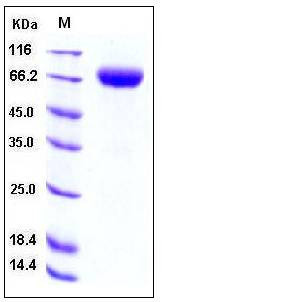Human 2B4 / SLAMF / CD244 Protein (Fc Tag)
2B4,NAIL,NKR2B4,Nmrk,SLAMF4
- 100ug (NPP3550) Please inquiry
| Catalog Number | P10042-H02H |
|---|---|
| Organism Species | Human |
| Host | Human Cells |
| Synonyms | 2B4,NAIL,NKR2B4,Nmrk,SLAMF4 |
| Molecular Weight | The recombinant 2B4/CD244/Fc chimera is a disulfide-linked homodimer. The reduced monomer comprises 438 amino acids and predicts a molecular mass of 49 kDa. As a result of glycosylation, the rh2B4/CD244/Fc monomer migrates as an approximately 70-80 kDa band in SDS-PAGE under reducing conditions. |
| predicted N | Cys 22 |
| SDS-PAGE |  |
| Purity | > 97 % as determined by SDS-PAGE |
| Protein Construction | A DNA sequence encoding the extracellular domain (Met 1-Arg221) of human 2B4 / CD244 (NP_057466.1) precursor was expressed with the C-terminal fused Fc region of human IgG1. |
| Bio-activity | 1. Measured by its binding ability in a functional ELISA. Immobilized human CD48 at 10 μg/ml (100 μl/well) can bind recombinant human 2B4 / CD244 with a linear range of 0.004-0.4 μg/ml. 2. Measured by its ability to bind biotinylated mouse CD48 in a functional ELISA. |
| Research Area | Immunology |Adaptive Immunity |Costimulation & Costimulatory Molecule |SLAM Family |
| Formulation | Lyophilized from sterile PBS, pH 7.4 1. Normally 5 % - 8 % trehalose and mannitol are added as protectants before lyophilization. Specific concentrations are included in the hardcopy of COA. |
| Background | The CD244 antigen, also known as 2B4, is a cell surface glycoprotein implicated in the regulation of natural killer and T lymphocyte function. 2B4 is a member of the signaling lymphocyte activation molecule (SLAM)-related receptor family and is important for stimulating NK cell cytotoxicity and cytokine production, which is expressed on all NK cells, a subpopulation of T cells, monocytes and basophils. The 2B4 antigen identified on NK cells and T cells is capable of transmitting stimulatory signals and non-MHC-restricted killing. Reported as an activating receptor, human 2B4 can effectively activate and enhance NK cell–mediated cytotoxicity, induce secretion of IFN-γ and matrix metalloproteinases (MMPs), as well as NK cell invasiveness. As a cell surface glycoprotein of the Ig-superfamily structurally related to CD2-like molecules such as CD2, CD48, CD58, CD84, Ly-9, and SLAM, 2B4 (CD244) is expressed on all human NK cells, a subpopulation of T cells, basophils and monocytes. 2B4 activates NK cell mediated cytotoxicity, induces secretion of IFN-gamma and matrix metalloproteinases, and NK cell invasiveness. |
| Reference |
